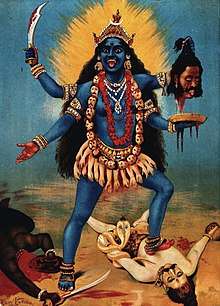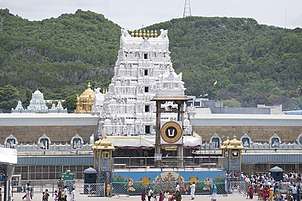Rajahmundry
Rajahmundry (officially known as Rajamahendravaram[6]) is a city in the Indian state of Andhra Pradesh. The city is located on the banks of River Godavari in the East Godavari district of the state. The city is the 4th most populated city in the state[7]. During British rule, the District of Rajahmundry was created in the Madras Presidency in 1823.[8] It was reorganised in 1859 and bifurcated into the Godavari and Krishna districts. Rajahmundry was the headquarters of Godavari District, which was further bifurcated into East Godavari and West Godavari districts in 1925. When the Godavari District was bifurcated, Kakinada became the headquarters of East Godavari and Eluru became the headquarters of West Godavari.[9] It is administered under Rajahmundry revenue division.[10][11] The city is known for its floriculture, history, culture, agriculture, economy, tourism, and its heritage.[12] It is known as the " Cultural Capital of Andhra Pradesh ".
Rajahmundry | |
|---|---|
| Rajamahendravaram | |
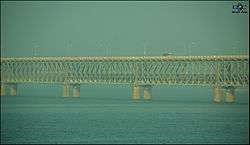 A train moving inside Rail/Road Bridge | |
| Nickname(s): Cultural Capital of Andhra Pradesh | |
.svg.png) Rajahmundry Location of Rajamahendravaram in Andhra Pradesh | |
| Coordinates: 16.98°N 81.78°E | |
| Country | India |
| State | Andhra Pradesh |
| Region | Coastal Andhra |
| District | East Godavari |
| Founded by | Rajaraja Narendra |
| Government | |
| • Body | Rajamahendravaram Municipal Corporation (RMC)[1] Godavari Urban Development Authority (GUDA)[2] |
| Area | |
| • City | 217.80 km2 (84.09 sq mi) |
| Elevation | 14 m (46 ft) |
| Population | |
| • City | 579,802 |
| • Metro | 10,39,894 |
| Languages | |
| • Official | Telugu |
| Time zone | UTC+5:30 (IST) |
| PIN | 533 1xx |
| Telephone code | +91-883 |
| Vehicle registration | AP 05 |
The city's name was derived from Raja Raja Narendra, the ruler of Chalukya dynasty of 11th century who ruled over the city[13]. The city's name was officially changed to Rajamahendravaram from earlier name Rajahmundry[14].
Korukonda, Konthamuru, Quarry Junction, Rajanagaram, Narendrapuram, Diwancheruvu, Luthergiri, Katheru, Vemagiri, Dowleswaram, Satellite City, Kadiam, Kadiyapulanka, RCR Bridge, Danavaipeta, ILTD Junction, Hukumpeta are some of popular localities in city.
Etymology
The city earlier was called Rajamahendravaram, derived from the Sanskrit name Rajamahendrapuram (The city of King Mahendra).[15] Carrying the same meaning, it is also referred to as Rajamahendri, which during the British colonial era became Rajahmundry. On 10 October 2015, the State Government of Andhra Pradesh officially renamed the city with its original name.[16]
History
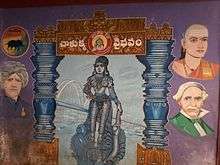
Rajahmundry was established by Ammaraja Vishnuvardhana the First (919–934 AD). The city as a prominent settlement can be traced back to the rule of the Eastern Chalukya[17] king Rajaraja Narendra, who reigned around 1022 AD.[18] Remains of 11th-century palaces and forts still exist.[19]
Rulers:[20]
- Eastern Chalukyas
- Kakatiyas
- Reddy and Gajapathi Rulers
- Vijayanagar Rulers
- Nizam Rule
- European Rulers and Zamindars
Rajahmundry was under Dutch rule for some time. In 1602, the Dutch constructed a fort here. In 1857, the British conquered the Dutch. They converted it into a jail in 1864 and elevated it into a central jail in 1870. The jail is spread over 196 acres (79 ha) out of which the buildings occupy 37.24 acres (15.07 ha).
In the Madras Presidency, the District of Rajahmundry was created in 1823.[8] It was reorganised in 1859 and was bifurcated into Godavari and Krishna districts. During British rule, Rajahmundry was the headquarters of Godavari district, which was further bifurcated into East Godavari and West Godavari districts in 1925. When the Godavari district was split, Kakinada became the headquarters of East Godavari and Eluru became headquarters of West Godavari.[21]
Rajahmundry was the hotbed of several movements during India's freedom struggle and acted as a base for many key leaders. When the Indian National Congress had its first meeting in Bombay (Mumbai), two leaders from Rajahmundry, Nyapathi Subba Rao and Kandukuri Veeresalingam, participated in it. Subba Rao, founder of Hindu Samaj in Rajahmundry, was also one of the six founders of India's noted English daily, The Hindu.
The Renaissance of Andhra Pradesh started in Rajahmundry. Kandukuri Veeresalingam is known as the Father of reforms in Andhra Pradesh. He started a monthly magazine Vivekavardhini, and a school for girls at Dowleswaram in 1874. The first widow remarriage took place on 11 December 1881. A society with 16 members was started on 22 June 1884, which used to look after widow remarriages in Rajahmundry. The town hall was established in 1890 by Veeresalingam. Bipin Chandra Pal visited Rajahmundry in April 1905 during the Vandemataram Movement. During his visits, he used to address the public in "Pal Chowk" (the present-day Kotipalli Bus Stand). Annie Besant visited Rajahmundry twice. First, she came during the foundations of a branch of the Divya Gyan Samaj at Alcot Gardens were being laid. She came again during the opening ceremony. Ramakrishna Mission was established in the city during 1950–51 near Kambal tank. The place is now the Ayakar Bhavan.
Rajahmundry is acclaimed as the birthplace of the Telugu language—its grammar and script evolved from the pen of the city-born poet Nannayya. Also known as 'Ādi Kavi' (the first poet) of Telugu, Nannayya, along with Tikkana and Yerrana, translated the Sanskrit version of Mahabharata into Telugu. Kandukuri Veeresalingam – a social reformer and the author of Rajashekhara Charithra, the first Telugu novel – was also from Rajahmundry.
Geography
Rajahmundry is located at 16.98°N 81.78°E.[22] with an average elevation of 14 metres (46 ft). It is geographically located at centre of Godavari Districts.There is paddy, sugarcane and various varieties of flowers cultivation in the area. River Godavari flows through the west of Rajahmundry.
The Rajahmundry traps, part of the Deccan Traps, are located on the Godavari river and are of particular interest to geologists.[23]
Climate
The weather is hot and humid, with a tropical climate and, therefore, no distinct seasons. The mean maximum temperature is 32 °C. The hottest season is from April to June, with temperature ranging from 34 °C to 48 °C with maximum of 52 °C recorded in May 2002 and May 2007. The coolest months are December and January, when it is pleasant at 27 °C to 30 °C. There is heavy monsoon rain at the end of summer, with depressions in the Bay of Bengal.
| Climate data for Rajahmundry | |||||||||||||
|---|---|---|---|---|---|---|---|---|---|---|---|---|---|
| Month | Jan | Feb | Mar | Apr | May | Jun | Jul | Aug | Sep | Oct | Nov | Dec | Year |
| Average high °C (°F) | 29 (84) |
32 (90) |
37 (99) |
40 (104) |
44 (111) |
40 (104) |
37 (99) |
33 (91) |
32 (90) |
32 (90) |
29 (84) |
27 (81) |
34 (94) |
| Average low °C (°F) | 19 (66) |
21 (70) |
23 (73) |
27 (81) |
29 (84) |
27 (81) |
26 (79) |
25 (77) |
25 (77) |
24 (75) |
21 (70) |
18 (64) |
24 (75) |
| Average precipitation mm (inches) | 3 (0.1) |
6 (0.2) |
11 (0.4) |
21 (0.8) |
67 (2.6) |
142 (5.6) |
260 (10.2) |
187 (7.4) |
177 (7.0) |
197 (7.8) |
37 (1.5) |
7 (0.3) |
1,115 (43.9) |
| Source: en.climate-data.org | |||||||||||||
Demographics
| Year | Pop. | ±% |
|---|---|---|
| 1871 | 19,738 | — |
| 1881 | 24,555 | +24.4% |
| 1891 | 28,397 | +15.6% |
| 1901 | 36,408 | +28.2% |
| 1911 | 48,417 | +33.0% |
| 1921 | 53,791 | +11.1% |
| 1931 | 63,526 | +18.1% |
| 1941 | 74,564 | +17.4% |
| 1951 | 105,276 | +41.2% |
| 1961 | 130,002 | +23.5% |
| 1971 | 188,805 | +45.2% |
| 1981 | 267,749 | +41.8% |
| 1991 | 324,881 | +21.3% |
| 2001 | 315,251 | −3.0% |
| 2011 | 648,558 | +105.7% |
As of 2011 Census of India, the city had a 648,558 and metro population 1,039,894.[15] 29,883 children are in the age group of 0–6 years, of which 15,152 are boys and 14,731 are girls—a ratio of 972 per 1000. The average literacy rate stands at 84.28% (male 88.14%; female 80.54%) with 264,653 literates, significantly higher than the national average of 73.00%.[4][24]
Governance
Rajahmundry is spread over an area of 238.5 km2 (92.1 sq mi) and metro area of 770.73 km2 (297.58 sq mi) with population of 648,558 and metro population 1,039,894.[2]</ref>[25] The Government is constructing an Under Ground Drianage system in the city.[26] The govt of AP merged of 23 surrounding villages from Korukonda, Rajanagaram, Rajahmundry Rural and Kadiam Mandals into Rajahmundry Municipal Corporation and upgraded to Greater Rajamahendravaram Municipal Corporation (GRMC).[2] The city has now achieved greater status. AP govt issued GO no:85 on 28 Jan 2020 and published it in the Gazette on 31.01.2020. Godavari Urban Development Authority (GUDA) is also working for the progress of new master plan.
Present representatives of City:
- Margani Bharat Ram (Rajahmundry Lok Sabha).
- Jakkampudi Raja (Rajanagaram).
- Gorantla Butchaih Chowdary (Rajahmundry Rural).
- Adireddy Bhavani (Rajahmundry Urban).
Mandals in city:
- Seethanagaram
- korukonda
- Rajanagaram
- Rajahmundry Urban
- Rajahmundry Rural
- Kadiam.
Floriculture
Rajahmundry is also famous for flowers. Various varieties of flowers are cultivated here. Nurseries here are spread more than 3,500 acres in Kadiam, Rajahmundry Rural mandals of City. Floriculture is expanding to Mandapeta town. Central Floriculture Institute and Research Centre is in construction at Vemagiri in the city.[27] Government is exporting these flowers from Rajahmundry Airport through Cargo planes.
Economy
Rajahmundry is a commercial hub for East Godavari and West Godavari Districts. Nurseries in Kadiam Mandal of city generates huge revenue to Rajahmundry revenue division. A floriculture research centre is in construction at Vemagiri, Rajahmundry to give a major boost to nurseries in Godavari Districts. Floriculture is expanding to Mandapeta, Alamuru and Atreyapuram Mandals. Main Road and Tadithota are main marketing places in the city. Many shopping complexes, multiplexes, hotels and convention halls are in construction near NH 216A (old NH 16) and it is becoming another shopping centre. Tourism also generate revenue to this region.[28] It is one of the largest bullion markets in India which consists hundreds of gold, silver and platinum shops throughout the city.
Industries and employment
Rajahmundry City is an industrial hub with huge industries generating employment. Rajahmundry City is the headquarters for ONGC, GAIL in K.G Basin. Godavari Districts are one of the largest petrochemical hubs in India. There are two huge paper mills in the city located at Luthergiri and Kadiam. There are two power plants in city i.e., GMR Power Plant and Vijjeswaram Hydel Power Plant. Government of Andhra Pradesh have set up industrial parks and industrial clusters at Nidigatla, Pallakadiam, Rajanagaram, Kadiyam, Jegurapadu areas in the city.[29] The present five-year plan of district consists of making Rajahmundry City as an IT Hub.
Culture
Art and crafts
Damerla Rama Rao Art Gallery – It is dedicated to the works of the artist Damerla Rama Rao of the city has various paintings by him such as Krishna Leela, Godavari of Eastern Ghats and Milkmaids of Kathiawar.[30]
Ratnam pens – These are the first handcrafted pens in India since 1932.[31] The pens are made from ebonite with gold or silver plated nibs. Ratnamson is a brand name of the K.V.Ratnam and sons, Ratnam Ball pen works at Fort Gate, Rajmudry.[32]
Literature
Nannayya is the earliest known Telugu poet, and the author of the first third of the Andhra Mahabharatam, a Telugu retelling of the Mahabharata. Sri Kandukuri Veeresalingam (1848–1919), a renowned social reformer, is widely considered as the man who first brought about a renaissance in Telugu literature and Telugu people; he is also known to have fought for women's issues.[33] General Sir Arthur Thomas Cotton, (15 May 1803 – 24 July 1899) was a British general and irrigation engineer.[34] Sri Adurthi Subba Rao, Prominent Old-time Director & Producer of Telugu Films. Julia Maitland, a campaigner for "native" education, founded a multilingual school and reading room in the town in 1837.[35]
Music and films
Durga Cinetone was the first south Indian film studio, to be built in Rajahmundry in the year 1936 by Nidamarthi Surayya. Many other films are being shot in the city.[36]
The city has produced many well-known artists in the Telugu film industry such as S.V.Ranga Rao, Ali, Raja Babu, Jaya Prada, Sameera Reddy, Bhanupriya, Sriman, Meghna Reddy, Thotakura Venkata Raju, Uma Pemmaraju, Ramesh, and J. D. Chakravarthy.
Tourism
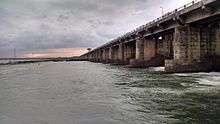
The river Godavari and its bridges and the Sir Arthur Cotton Museum[37] are some of the attractions in the city. Rajahmundry is a tourist destination in the state. Daily tourist boats are availed from Pushkar Ghat to Papikondalu and Bhadrachalam. Heli Tourism is introduced from Rajahmundry Airport to see tourist places in Godavari Districts. Nurseries in Kadiam Mandal of City is another tourist destination. Government of Andhra Pradesh is rehabilitating Havelock Bridge and constructing resorts, convention centers, film studios, hotels, recreational places at Pichukalanka and other islands on River Godavari and eco-tourism centre at Kadiyapulanka, Zoological Park. Government of Andhra Pradesh is constructing Rajahmundry International Cricket Stadium on PPP mode to host international matches.[38] Greater Rajamahendravaram Municipal Corporation (GRMC), Godavari Urban Development Authority (GUDA) and Andhra Pradesh Tourism Development Corporation (APTDC) is planning River Front Development on 22 km stretch of River Godavari from Venkatanagaram to Vemagiri. State Government is making MoUs with private agencies for Malls, Multiplexes, Hotels, Convention Centers and Recreational places on PPP mode as a part of tourism development. Rajahmundry Airport is being developed as an international airport for giving a major boost to tourism in Godavari Districts. Polavaram Project, which is 25 km away from city will become another major tourist site near city.[39]
Transport
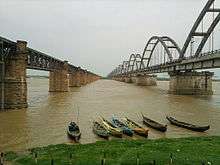
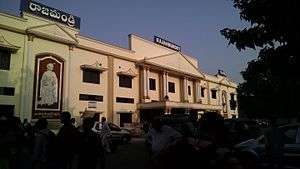
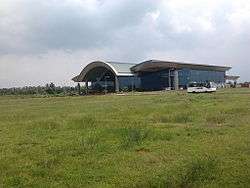
The bridges across Godavari River are an important transport infrastructure for connectivity such as, the Godavari Bridge,[40] which is the third longest railroad bridge in India;[41] and the Godavari Arch Bridge, commissioned on 14 March 1997 for Howrah–Chennai main line.[42] While, the Old Godavari Bridge (The Havelock Bridge) was the earliest of all, built in 1897 and was decommissioned in 1997.[41][43][44] The city also has Dowlaiswaram Cotton Barrage bridge and fourth bridge on either side of the main city that connects the highways of East Godavari and West Godavari districts.
Roads
Rajahmundry is very well connected to the state and rest of India with network of state and national highways. NH 16 passes through the city. NH 365BB, NH-516D connects the city with Khammam, Suryapet and Hyderabad. NH 216A which is a spur road to NH 16 connects the city with Ravulapalem, Tanuku, Tadepalligudem and Eluru. NH 516E connects the city with Vizianagaram via Rampachodavaram, Narsipatnam and Araku. ADB Road and SH 40(Canal Road) connects the city with Kakinada and SH 41 is connected with Odisha, Chhattisgarh, Telangana borders with Andhra Pradesh and Bhadrachalam. SH 104 connects the city with Amalapuram. SH 172 is connected to Purushottampatnam and Polavaram Project. SH 72 is connected to Nidadavole, Palakollu and Narsapuram, Bhimavaram. NHAI is constructing flyovers on NH 16 and NH 216A at Diwancheruvu, Lalacheruvu, Morampudi, Vemagiri and Kadiyapulanka Junctions in the city to ease traffic. Trumpet Bridge is being constructed at ADB road on NH 16 in Rajanagaram. A ROB was proposed from Morampudi to Kotipalli Bus stand. Godavari Urban Development Authority (GUDA), Greater Rajamahendravaram Municipal Corporation (GRMC) are constructing an outer ring road (ORR) for the city to ease traffic in the city.
Railways
Rajahmundry railway station is classified as an A category station.[45] It is located on the Howrah-Chennai main line of South Central Railway zone. Godavari and Kadiam, Kovvur are other railway stations serving to city. Second railway line is proposed on Godavari Arch Bridge. A new railway line to Raipur from the city connecting Rampachodavaram and other East agency areas was in proposal. The frequency of trains will be increased after completion of Kovvur-Bhadrachalam railway line and distance to Secunderabad Railway Station will be decreased.[46]
Waterways
National Waterway 4 was declared on 24 November 2008, which connects the Indian states of Telangana, Andhra Pradesh, Tamil Nadu, and the union territory of Puducherry. It passes through Kakinada, Rajahmundry, Tadepalligudem, Eluru, Commanur, Buckingham Canal and also part of Krishna and Godavari rivers. Kakinada Port is the nearest port to the city. New Commercial Port is in construction at Kakinada City by GMR on PPP mode. Narsapuram Port is proposed according to AP State Reorganisation Act.[47] It is being developed by Inland Waterways Authority of India.Inland water port is proposed at Bobbillanka. APTDC and other private agencies' boats and launches are available daily from Pushakar Ghat to Papikondalu and Bhadrachalam.[48]
Airways
Rajahmundry Airport is situated at Madhurapudi, in the outskirts of Rajahmundry City.[49] This airport is being served to people of Godavari Districts. A new terminal building was inaugurated on 16 May 2012. Runway was expanded from the 1,749 m to 3,165 m. Rajahmundry Airport's runway is the second longest runway in the state of Andhra Pradesh. Government proposed an IAF base in this airport. This airport plays a crucial role in economy of Godavari Districts. Government of AP is keen in exporting flowers through this airport from nurseries in Kadiam Mandal in the city. The airport is all set for belly cargo services along with the introduction of wide-body aircraft such as Airbus A320 and Boeing 737. Currently, Rajahmundry airport serves direct flights to and fro the destinations namely Bengaluru, Chennai, Hyderabad, Tirupati and Visakhapatnam. There is a demand for direct flight services to Delhi, Mumbai and Kolkata. Heli tourism has been introduced in the airport.[50]
Education
The primary and secondary school education is imparted by government, aided and private schools, under the School Education Department of the state.[51][52] As per the school information report for the academic year 2016–17, the city has 55,501[53] students enrolled in 244 schools.[54] The medium of instruction followed by schools are Telugu, English.[55][56] The Railway High School in the city has a history of more than hundred years, established in the year 1909.[57]
The city has one of the thirteen regional offices of the Board of Intermediate Education, which administers Intermediate education (10+2) education.[58] The Government Junior College is the only government run junior college, established in 1974 and there are four private-aided, twenty private-unaided colleges in the city.[59]
The Government Arts College was founded more than 150 years ago by the reformer, Kandukuri Veeresalingam Panthulu.[60] The BEd Training Institute is one of the oldest in India. Adikavi Nannaya University was established in March 2006, named after an 11th-century poet, Nannayya.[61] Other major universities in the city include Sri Potti Sri Ramulu Telugu University,[62] Acharya NG Ranga Agricultural University,[63] Dr. B.R. Ambedkar Open University Study Center.[64] the city contains nannya university as new era. Andhra Pradesh State Forest Academy is located in the city for Forest skills training.[65]
National Institute of Technology, Andhra Pradesh, Tadepalligudem is located 34 km from Rajahmundry city.
Central Government Institutions in the city are as follows:
- "Central Tobacco Research Institute (CTRI)".
- "National Centre for Disease Control (NCDC)".
- "National Academy of Constructions (NAC)".[61]
"Central Floriculture Institute and Research Centre" is in construction at Vemagiri.[27] "Science City" is in construction at Bommuru.[66]
After the Reorganization of Andhra Pradesh State the following institutes are sanctioned for the city:
- "Indian Institute of Petroleum and Energy (IIPE)".
- "National Civil Aviation Academy".[59]
- "National Institute of Drama (NID)".
- "AP State Forest Academy".[57]
See also
- List of cities in Andhra Pradesh
- List of municipal corporations in India
References
- https://rajahmundry.cdma.ap.gov.in/en/rajamahendravaram-municipal-corporation. Missing or empty
|title=(help) - "Greater Rajamahendravaram Municipal Corporation (GRMC)". 14 January 2020 – via www.thehansindia.com.
- "Municipalities, Municipal Corporations & UDAs" (PDF). Directorate of Town and Country Planning. Government of Andhra Pradesh. Retrieved 23 June 2016.
- "Census of India: Search Details". Office of the Registrar General & Census Commissioner, India. Retrieved 23 May 2017.
- "Agglomerations and Cities". citypopulation.de.
- Reporter, Staff (17 October 2015). "Rajahmundry is now 'Rajamahendravaram'". The Hindu. Vijayawada. Retrieved 16 May 2019.
- "Andhra Pradesh (India): Districts, Cities and Towns - Population Statistics, Charts and Map". www.citypopulation.de. Retrieved 29 July 2020.
- Bhaskar, B. v s (8 June 2014). "'Nyapathi Subbarao carved an identity for Telugus'" – via www.thehindu.com.
- "East Godavari District Mandals" (PDF). Census of India. pp. 365–366, 409. Retrieved 21 June 2018.
- "District Census Handbook – East Godavari" (PDF). Census of India. p. 3,16–17. Retrieved 21 June 2018.
- "Andhra Pradesh (India): Districts, Cities, Towns and Outgrowth Wards – Population Statistics in Maps and Charts".
- "FM waves to touch Rajahmundry soon". 28 July 2006 – via www.thehindu.com.
- "Andhra Pradesh Government to Rename Rajahmundry as Rajamahendravaram". NDTV.com. Retrieved 26 July 2020.
- Reporter, Staff (17 October 2015). "Rajahmundry is now 'Rajamahendravaram'". The Hindu. ISSN 0971-751X. Retrieved 26 July 2020.
- "Rajahmundry in AP renamed as Rajahmahendravaram – The Times of India". timesofindia.indiatimes.com. Retrieved 23 October 2015.
- "19th century coins unearthed from an Andhra Pradesh temple". NDTV.com.
- "Rajahmundry to get back it's [sic] original name".
- "All eyes on Rajahmundry central jail land". News18.
- "1000+ Years History (Since 919 AD)". History of Rajahmundry. Rajahmundry.net. Archived from the original on 14 October 2008. Retrieved 22 October 2008.
- Kalavalapalli, Yogendra (19 July 2016). "Pensioner's paradise Kakinada coming of age". Mint.
- "Maps, Weather, and Airports for Rajamahendravaram, India". fallingrain.com.
- Ajoy K Baksi. "Rajahmundry Traps: Deccan traps" (PDF). The Rajahmundry Traps, Andhra Pradesh: Evaluation of their petrogenesis relative to the Deccan Traps. Indian Academy of Science. Retrieved 23 October 2008.
- "Chapter–3 (Literates and Literacy rate)" (PDF). Registrar General and Census Commissioner of India. Retrieved 3 September 2014.
- "CommissionerProfile". Rajahmundry Corporation. Retrieved 21 July 2015.
- "Rajahmundry Municipal Corporation submits Rs 634 crore DPR on underground drainage". Deccan Chronicle. 2 April 2016.
- "floriculture" – via www.thehindu.com.
- "Regarding expansion and development of Rajamahendravaram Airport".
- "industries". 22 April 2016 – via www.thehindubusinessonline.com.
- "Damerla Rama Rao Art Gallery: a picture of neglect". The Hindu. 11 August 2015. Retrieved 2 July 2016.
- John, Paul (11 December 2016). "Pen with swadeshi writ" (Ahemdabad). Benett Colman &Co. Times of India. Retrieved 27 December 2019.
- Mehandiratta, Vaibhav. "Ratnamson Catelogue". www.mehandiratta.wordpress.com. Retrieved 27 December 2019.
- Reporter, Staff (12 December 2012). "'Kandukuri had pragmatic approach to social problems'" – via www.thehindu.com.
- "No documentary on Sir Arthur Cotton". 15 May 2009 – via www.thehindu.com.
- Letters from Madras, during the years 1836–1839, by a Lady (London, 1843).
- Ram, P (2014). Life in India. AnVi. p. 153. Retrieved 2 July 2016.
- "Museum being spruced for visit of Cotton's great-grandson". 28 November 2009 – via www.thehindu.com.
- "Andhra CM Approves Establishment of Archaeological Corporation Instructs Officials to Boost Tourism". 19 October 2019 – via ANI News.
- "Saluting Sir Arthur Cotton". 15 May 2008 – via www.thehindu.com.
- INDIA, THE HANS (17 February 2016). "Road-cum-rail bridge to be illuminated". www.thehansindia.com.
- R.R.Bhandari. "Bridges: The Spectacular Feat of Indian Engineering" (PDF). Indian Railway Service of Mechanical Engineers. Retrieved 6 August 2012. Cite journal requires
|journal=(help) - Dayaratnam, P. (2000). International Conference on Suspension, Cable Supported, and Cable Stayed Bridges: November 19-21, 1999, Hyderabad. Universities Press. p. 219. ISBN 9788173712715.
- Khan, Mukram. "The Havelock Bridge Memorial Stone". Flickr. Retrieved 1 August 2012.
- "Engineering Tourism". East Godavari district official website. Retrieved 8 June 2018.
- "Statement showing Category-wise No.of stations" (PDF). Indian Railways. p. 2. Retrieved 12 May 2017.
- Reporter, Staff (27 September 2012). "Railway station to have two more platforms" – via www.thehindu.com.
- Ministry of Shipping (Government of India). "National waterways Declaration". Archived from the original on 10 April 2009. Retrieved 5 August 2010.
- Press Information Bureau, Government of India (2 August 2010). "Development Authority for Inland Waterways in India". Retrieved 5 August 2010.
- Samaritan, Sampat G. (10 August 2016). "Rajahmundry airport tops in occupancy rates". Deccan Chronicle.
- "Rajahmundry airport terminal operational". The Hindu Business Line. 17 May 2012. Retrieved 24 June 2014.
- "School Education Department" (PDF). School Education Department, Government of Andhra Pradesh. Archived from the original (PDF) on 19 March 2016. Retrieved 13 November 2016.
- "The Department of School Education – Official AP State Government Portal". www.ap.gov.in. Retrieved 7 November 2016.
- "Student Information Report". Commissionerate of School Education. Child info 2015–16, District School Education – Andhra Pradesh. Retrieved 13 November 2016.
- "Student Information Report". Commissionerate of School Education. Child info 2016–17, District School Education – Andhra Pradesh. Retrieved 14 May 2017.
- Smith, Bonnie G. (2008). The Oxford Encyclopedia of Women in World History. Oxford University Press. ISBN 978-0-19-514890-9. Retrieved 14 May 2017.
- Bhattacharya, Sabyasachi (2002). Education and the Disprivileged: Nineteenth and Twentieth Century India. Orient Blackswan. ISBN 9788125021926. Retrieved 14 May 2017.
- "Railway school completes 100 years". The Hindu. Retrieved 14 May 2017.
- "Regional Offices". Board of Intermediate Education AP. Retrieved 14 May 2017.
- "List of colleges in Guntur district" (PDF). Board of Intermediate Education. Retrieved 27 September 2016.
- Reporter, Staff (12 March 2012). "Government Arts College receives NAAC certificate" – via www.thehindu.com.
- Bureau, Our (27 November 2016). "Nannaya University Developing as top". www.thehansindia.com.
- "Bifurcation blues in Potti Sreeramulu Telugu University". Deccan Chronicle. 23 August 2015.
- INDIA, THE HANS (21 April 2016). "PM Modi clears two more national institutes for AP". www.thehansindia.com.
- "Open university to set up study centres in Agency". 28 May 2008 – via www.thehindu.com.
- "Forest academy hones skills of staff". The Hans India. 6 May 2019. Retrieved 3 June 2019.
- "Science City" – via m.timesofindia.com.
External links
| Wikimedia Commons has media related to Rajahmundry. |
| Wikivoyage has a travel guide for Rajahmundry. |
- Rajahmundry at the Encyclopædia Britannica
- Literature by and about Rajahmundry in the German National Library catalogue
